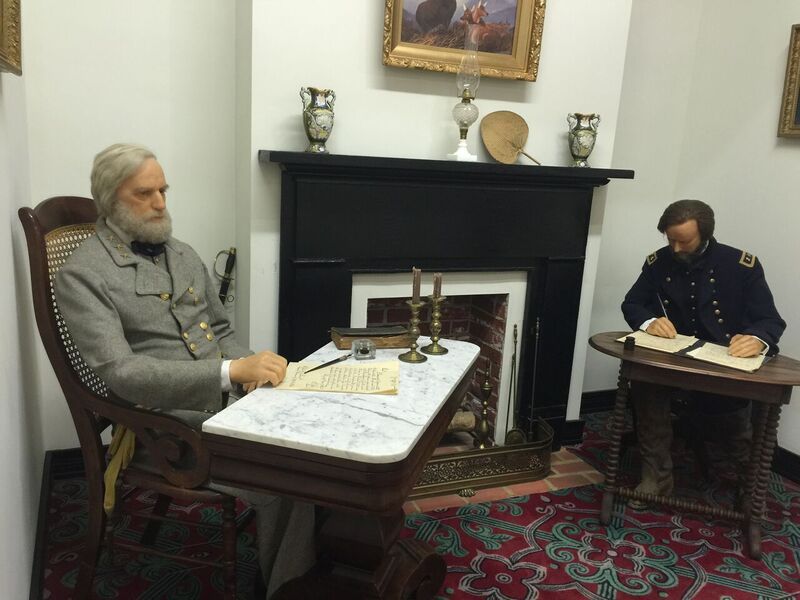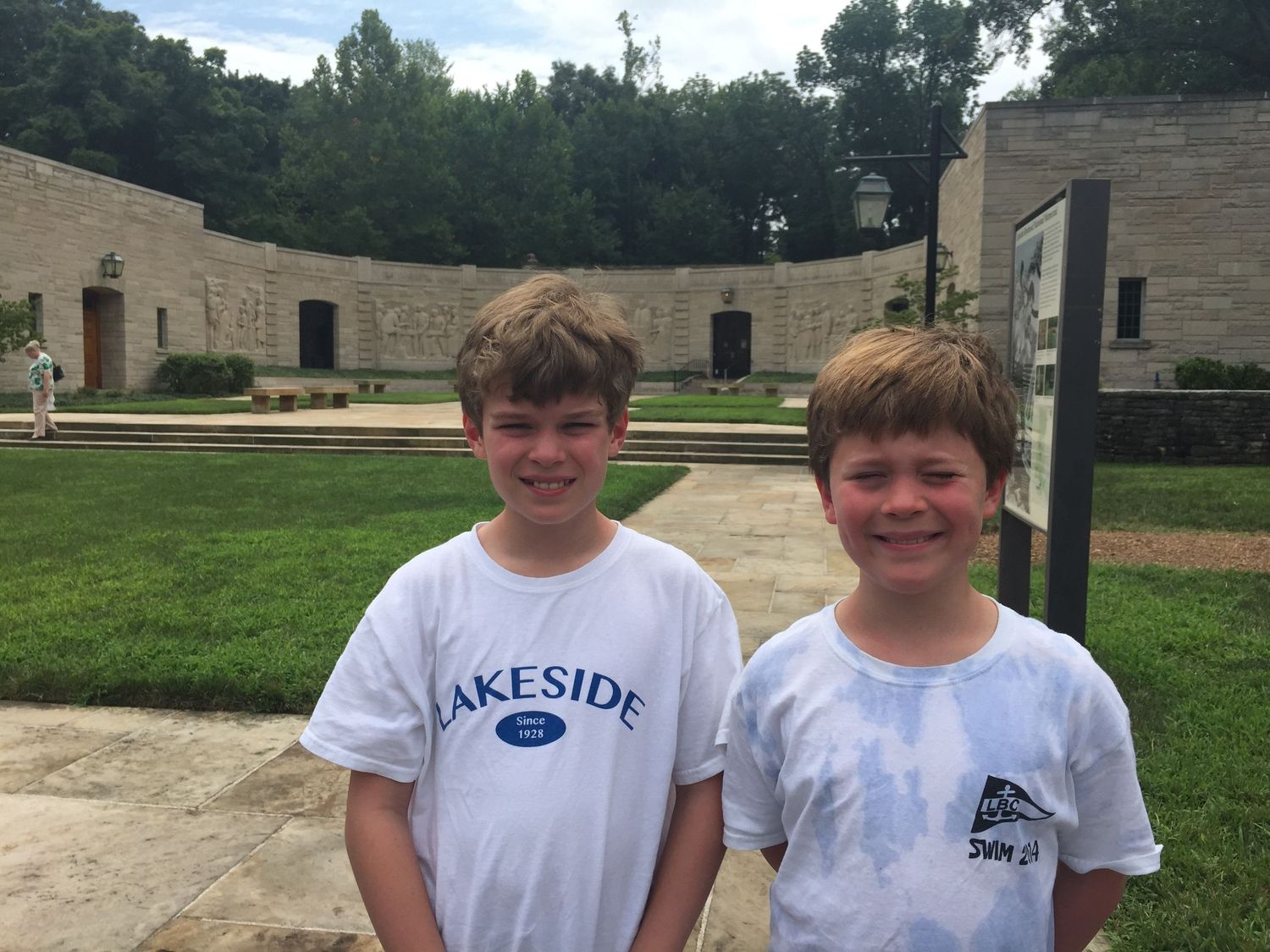In Lincoln’s Footsteps
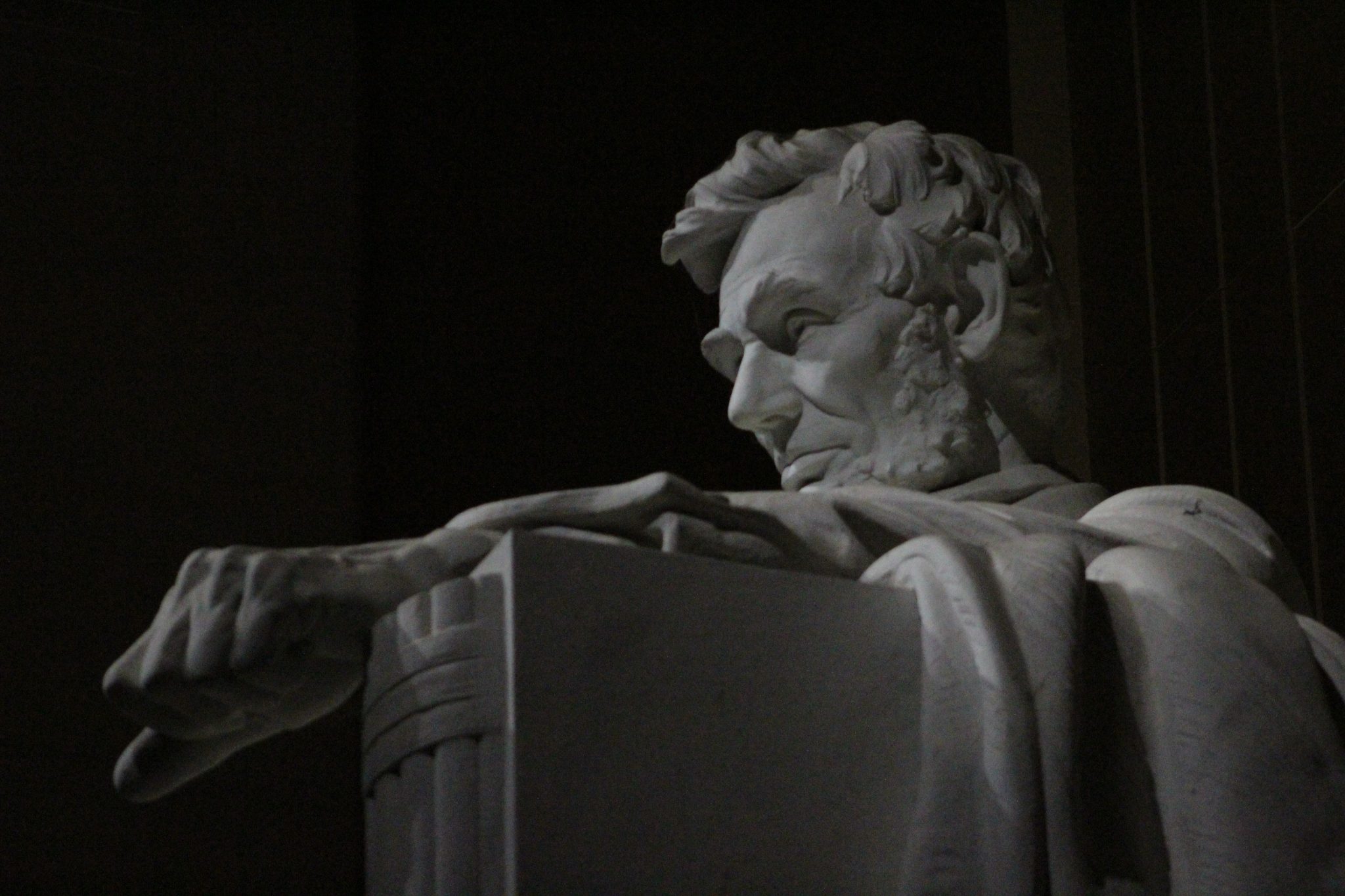
Travels with Joe | Year of Lincoln
How my sons and I traveled 1,600 miles in search of our 16th president
Growing up in Illinois, I claimed Abraham Lincoln as one of my own.
Though I was born 101 years after his assassination, the 16th president was often quoted in my home, as if he was a member of the family.
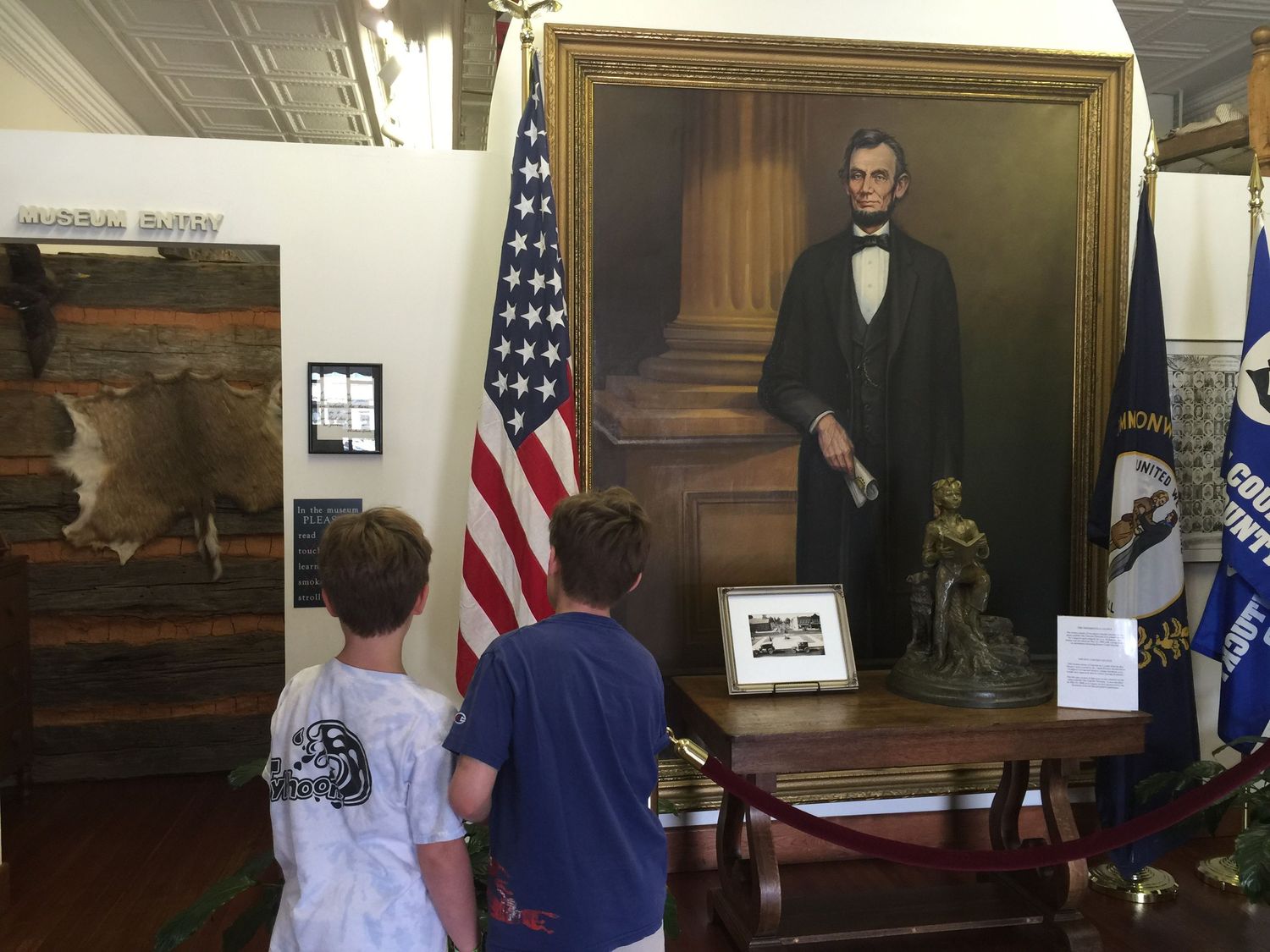
“Most folks are about as happy as they make up their minds to be.”
“He has a right to criticize, who has a heart to help.”
“All that I am or ever hope to be, I owe to my angel mother.”
Illinois’ license plates confirmed that we lived in “The Land of Lincoln,” and regular grade school pilgrimages to his home and tomb in Springfield cemented our kinship.
Despite my lifelong fascination with Mr. Lincoln, including mesmerizing late night visits to the Lincoln Memorial while a congressional intern in Washington, D.C., and a subsequent trip to Gettysburg, I inexplicably failed to take the next obvious steps on the Lincoln trail when I moved to Kentucky in 1994.
It was a pang in my brain for the next two decades….”I need to get to Lincoln’s birthplace.”
The motivation finally came as a duty to my own children, at 11 and 9 years old, about the age I was when my dad first loaded up the station wagon to show us the Illinois Lincoln sites.
Read about the Lincoln Birthplace National Park Centennial July 16-17
I declared 2015 as the “Year of Lincoln,” and by the time it was over, Sam, Henry, and I had marked pivotal mileposts in Abraham Lincoln’s timeline, from the Kentucky farm where he was born to the bedroom in the Washington, D.C., boarding house where he drew his last breath.
Hodgenville
From Louisville, Abraham Lincoln’s birthplace is an embarrassingly easy drive, only about 60 miles, most of it on Interstate 65.
Once off the interstate south of Elizabethtown, I encouraged Sam and Henry to put down their electronics to take in the landscape of Hardin and Larue County. Though farming is certainly more sophisticated now than in Lincoln’s day, the topography of the rolling farmland and tree line is certainly something he would recognize, even today.
This was the American frontier in 1808 when Lincoln’s father, Thomas Lincoln, bought the 300-acre Sinking Spring Farm south of present-day Hodgenville.
The extraordinary contrast of Lincoln’s humble beginnings to his place in American history is only meaningful if the traveler has a sense of Lincoln’s importance in the first place. It was a context I concluded my boys needed a better appreciation. And what better way to understand Lincoln than to walk and talk with the people who now live in his “hometown,” about two miles north of the Lincoln farm.
Our first stop was the Hodgenville town square, where Laha’s Red Castle has been grilling hamburgers behind an eight-stool lunch counter since 1934. We were fortunate enough to grab three seats at the counter, where three generations of Laha’s workers were eager to get to know us.
Cheeseburgers and fries quickly followed. As we lunched and talked, seemingly all of Hodgenville filed through to pick up their carry-out orders and briefly join the conversation. It was the kind of atmosphere I imagine the Lincolns would have felt right at home. Abraham Lincoln often spoke of his father’s jokes and humorous storytelling.
Leaving the restaurant, one of our fellow diners greeted us on the sidewalk with a wide smile and a gift for the Lincoln tourists, a cool watermelon from his garden. We like this place.
In the center of Hodgenville’s Lincoln Square sits President Lincoln himself, a 6-foot-high bronze statue atop a 12-foot pedestal. Erected to commemorate the centennial of Lincoln’s birth in 1909, the statue by sculptor Adolph Alexander Weinman (who also crafted the Lincoln statue in Kentucky’s Capitol rotunda) is a dignified reminder of Lincoln’s simple nobility.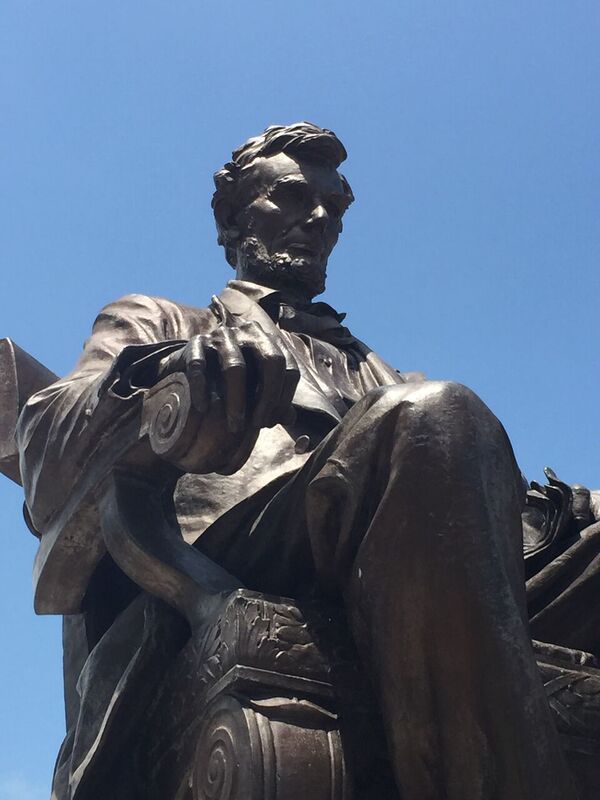
Lincoln’s son, Robert Todd Lincoln, joined the sculptor for the official unveiling, as described in the Louisville Courier-Journal:
“While ten thousand people stood in reverence with bared heads, and the sweet familiar strains of America, sung by hundreds of white-clad children, floated out upon the air, a veiling of the Stars and Stripes fell gracefully away from a bronze memorial of Abraham Lincoln, the man who fought to save the Union and won with his victory undying fame and love of former foes. The canopy that hid the statue from view was drawn away by the hand of Mrs. Ben Hardin Helm, a sister of the wife of Lincoln, and cheer after cheer went up.”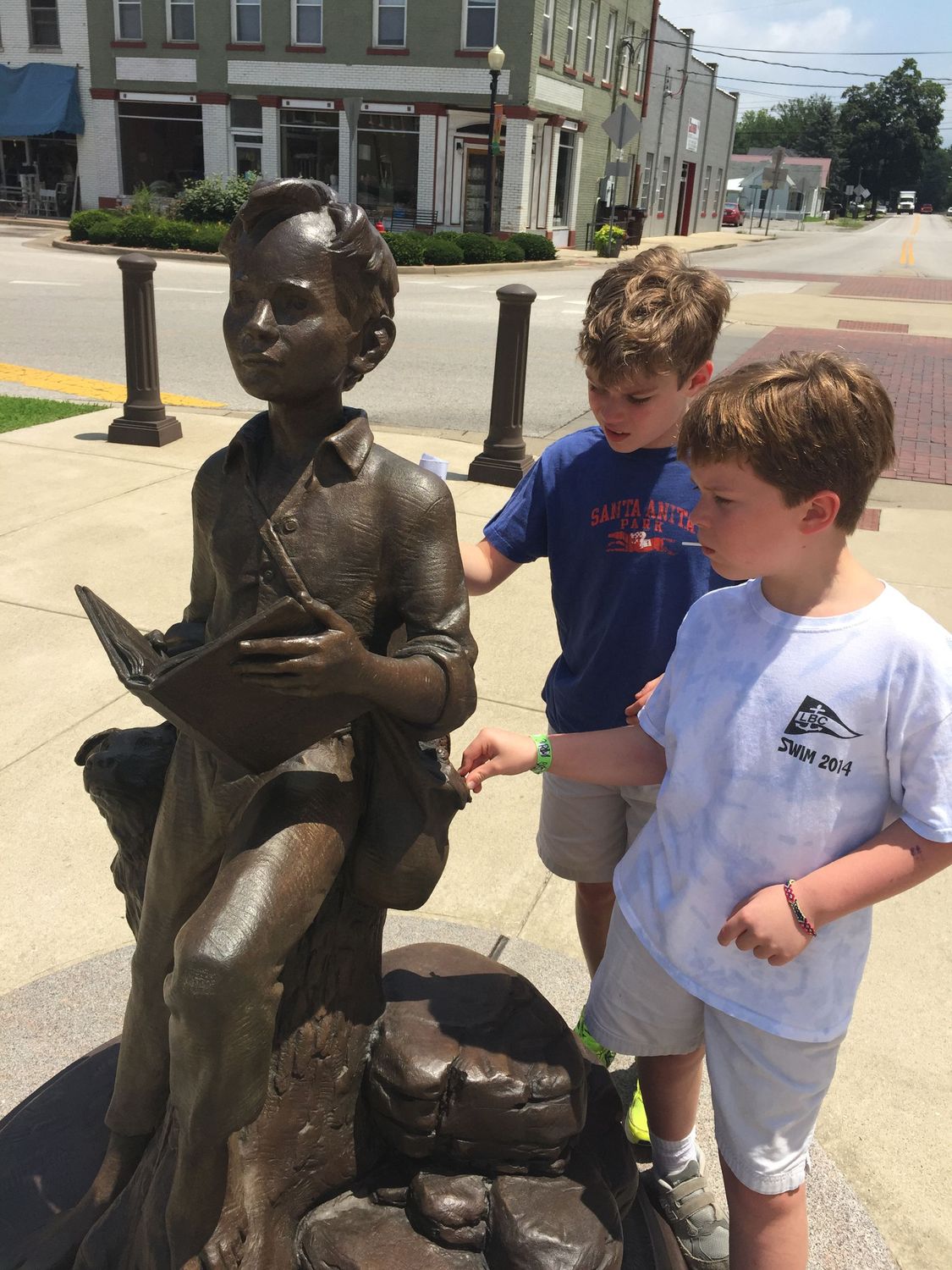
One hundred years later, in 2008, Hodgenville dedicated yet another statue of Lincoln in the city square. It cleverly and appropriately depicts Lincoln as a 7-1/2-year old child,
about the age he was shortly before his father moved the family to Indiana. The portrayal of the young Lincoln with his dog Honey at his side provides some of the context I sought to share the Lincoln story with Sam and Henry, who enjoyed looking into the statue’s eyes.
We followed those eyes to the homespun Lincoln Museum, also on Lincoln Square.
Lincoln Museum, Hodgenville
The Lincoln Museum has the charm of a proud parent’s scrapbook. Lincoln is considered a son of Hodgenville and the community spirit that helped build the museum in two historic buildings is sensed in its exhibits, including newspaper clippings, campaign posters, and Lincoln memorabilia. Randomly sprinkled among Lincoln artifacts are period clothing and heirlooms from Hodgenville history.
Consider donating more than the $3 admission for adults to help fund the effort.
A series of life-size dioramas allows visitors to witness key moments in Lincoln’s life. Wax figures offer a sort of walk-through comic book, with vignettes such as the young Abe reading in the light of the fireplace and the statesmen President Lincoln signing the Emancipation Proclamation. Where else can you see Lincoln’s debate rival Stephen Douglas brought back to life?

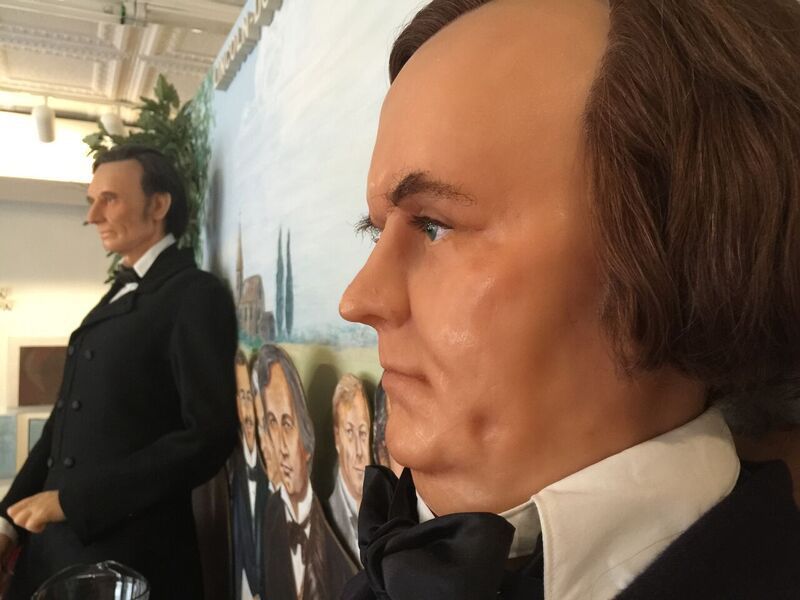
We spent about an hour walking through the exhibits, then ventured back across the square for dessert at The Sweet Shoppe. As we imagined the steamy heat ahead of us on the Lincoln farm, towering soft-serve ice-cream cones seemed an obvious choice. The Sweet Shoppe is also a traditional Kentucky State Fair vendor, selling 40 flavors of its signature fudge.
Abraham Lincoln Birthplace National Historical Park
Nourished in body and the Lincoln spirit, it was on to where it all began, the Abraham Lincoln Birthplace National Historical Park, just 2 miles away. Nestled in wooded farmland, a simple driveway lined by a split rail fence greets pilgrims to the Lincoln shrine.
The park is a study in contrasts, the sidewalk from a long, modest one-story visitors center leads to 56 stone steps—one for each year of Abraham Lincoln’s life—reaching the top of a knoll and a stately Greek temple-like Beaux-Arts memorial building.
Overwhelming the interior of the Connecticut pink granite and Tennessee marble structure is a log cabin not unlike the one in which Lincoln was born. The cabin itself has a complicated history of which the noteworthy conclusion is that it is not the cabin in which Lincoln was born, but its appearance symbolizes Lincoln’s humble beginnings.
 For a man whose life exemplified authenticity, the wooden structure reportedly reconstructed from the disassembled parts of two cabins of questionable origin is a somewhat disappointing remembrance. The shrine houses a fake relic.
For a man whose life exemplified authenticity, the wooden structure reportedly reconstructed from the disassembled parts of two cabins of questionable origin is a somewhat disappointing remembrance. The shrine houses a fake relic.
Yet the memorial evokes a very real sense of reverence for—as best as we know—the actual location where our American saint was born. For my children, the cabin provides a tangible representation of the Lincoln family’s hardscrabble existence.
Sam and Henry especially enjoyed the park ranger-led walking tour of the memorial, which includes descending into the base of the hillside to see the Sinking Spring, from which the farm gets its name.
“Abraham Lincoln probably tasted his first drink of water from this spring,” the National Park Service says in its characterization of the site, a cave opening into which the spring gently drains.
Rockport, Indiana
On the Ohio River, Rockport is a community of about 2,000 people. Incorporated in 1808 (a plaque in a river bluff marks the cave of James Langord, “the first white man with a family to live upon the present site of Rockport”) it is a city where Abraham Lincoln worked his first non-farm jobs as a young man. He was friends here with John Pitcher, the first attorney of Rockport, whose library helped introduce Lincoln to the world.
Lincoln’s legal career began in Rockport, when he was sued by a ferry company after accepting money to deliver passengers from the river bank to a steamboat in a rowboat. Lincoln won the case, arguing that he was only ferrying the passengers halfway across the river.  It was from Rockport on that river in 1828, a 19-year-old Lincoln and Allen Gentry, hired by Gentry’s father, took a flatboat loaded with produce to sell in New Orleans. That trip exposed Lincoln to the horrors of slavery.
It was from Rockport on that river in 1828, a 19-year-old Lincoln and Allen Gentry, hired by Gentry’s father, took a flatboat loaded with produce to sell in New Orleans. That trip exposed Lincoln to the horrors of slavery.
“If I ever get a chance to hit that thing, I’ll hit it hard,” a plaque on the river bank quotes Lincoln of his witness to slavery.
Carved into a portion of Rockport’s city park is an opportunity to walk through Abraham Lincoln’s young life.
The Lincoln Pioneer Village and Museum was the brainchild and dream in the 1930s of George H. Honig, a sculptor and Lincoln historian, of Rockport. Built by the Works Projects Administration, the collection of replica cabins allows visitors to explore life on the Indiana frontier, including Lincoln’s home, school, and church.
Honig’s goal was to “visualize the Spencer County environment in which Lincoln lived during the 14 formative years of his life, from 1816 to 1830.” Trivia: the Burt Lancaster movie The Kentuckian was filmed at the village in 1954. It was Walter Matthau’s first film.
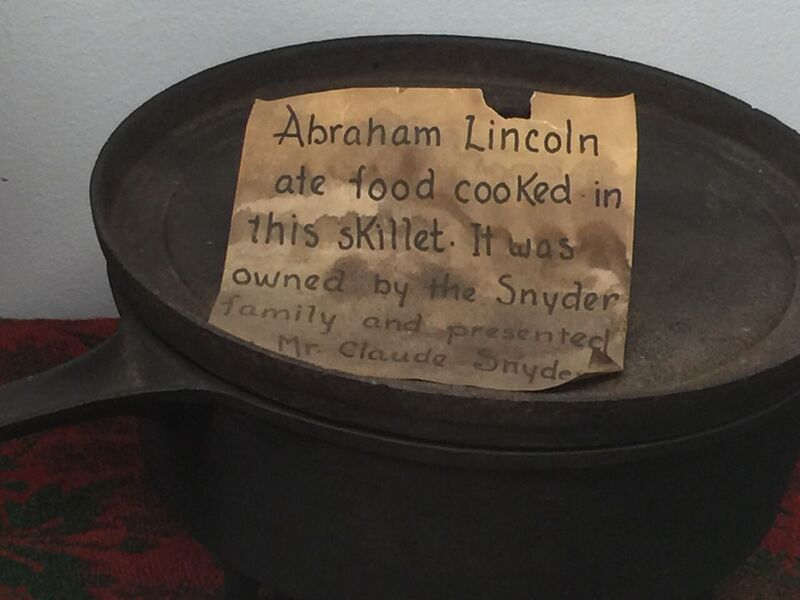 The museum’s glass cases are stacked with Lincoln memorabilia and collectibles, much of it handed down from previous generations with curious provenance, but intriguing to say the least. Examples include a cane reputedly cut by Lincoln, a broad ax said to have been used by him, a block of wood “taken from log of the Lincoln log cabin,” and a skillet.
The museum’s glass cases are stacked with Lincoln memorabilia and collectibles, much of it handed down from previous generations with curious provenance, but intriguing to say the least. Examples include a cane reputedly cut by Lincoln, a broad ax said to have been used by him, a block of wood “taken from log of the Lincoln log cabin,” and a skillet.
“Abraham Lincoln ate food cooked in this skillet,” a placard reads.
Lincoln Boyhood Home
The actual farm where Abraham Lincoln grew up is about 16 miles to the north of Rockport, now “Lincoln City,” the home of the Lincoln Boyhood National Memorial run by the U.S. Park Service.
With a parking lot that gives easy access to the museum, the memorial is a semi-circle of five bas-relief stone panels depicting different phases of Lincoln’s life, in Kentucky, Indiana, Illinois, and Washington, D.C..
Inside, another Thomas Lincoln hutch (he was a prolific carpenter) and the composite painting of Lincoln’s mother, Nancy Hanks, based on descriptions of her and the “Hanks look.” No photographs are known to exist of her.
A 15-minute film (narrated by the late Leonard Nimoy) helps place Lincoln in the Indiana surroundings and in the pioneer days of two centuries ago, recalled by Lincoln in a poem he wrote after visiting his childhood home in 1844.
When first my father settled here,
‘Twas then the frontier line:
The panther’s scream, filled night with fear
And bears preyed on the swine.
In 1818, when Lincoln was 9 years old, two years after moving to Indiana, his mother died of “milk sickness,” after drinking milk of cows who had grazed on a toxic plant in the woods.
Fifteen years after Lincoln’s assassination, manufacturer Peter Studebaker paid to erect the headstone that still stands at Hanks’ grave in a quiet hilltop cemetery that includes about 20 other pioneers. The cemetery is about a 300-yard walk up an incline from the museum. Visitors toss pennies at the foot of the headstone.
When Lincoln’s son, Robert Todd Lincoln, gave $1,000 for the care of his grandmother’s grave in 1900, Spencer County reciprocated, appropriating $800 to purchase 16 acres surrounding the gravesite, the beginning of the memorial park. The landscape was designed by Frederick Law Olmsted Jr.
 Winding through the woods with the buzz of insects and frequent flashes of butterfly wings, the trek helped us travel back in time. It was easy to imagine Lincoln at the same ages as my two sons roaming these woods, splitting rails for fences, learning his father’s craft. Past rail fences and a cornfield, and atop another hill, the Living Historical Farm depicts the Lincoln family homestead.
Winding through the woods with the buzz of insects and frequent flashes of butterfly wings, the trek helped us travel back in time. It was easy to imagine Lincoln at the same ages as my two sons roaming these woods, splitting rails for fences, learning his father’s craft. Past rail fences and a cornfield, and atop another hill, the Living Historical Farm depicts the Lincoln family homestead.
Upon entering the cabin appointed with what the family would have likely seen in the 1820s, a chair-maker greeted us. The workers at the farm do not pretend to be in the 1800s, but answer questions and explain the history and details of that time period.
Living in a city, my sons were as enamored by roving chickens and a rain barrel brimming with tree frog tadpoles, but maybe a young Abe Lincoln was too. One of the woodworkers allowed both Sam and Henry to use a blade to shave a wooden peg for use on the rail fences.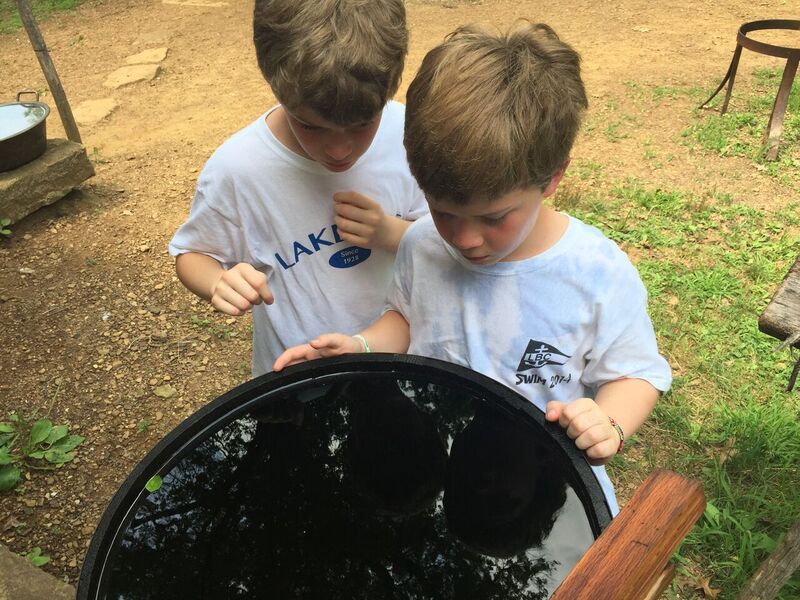
The grounds are open year-round and the farm is staffed from mid-April through September.
After Lincoln visited his boyhood neighborhood in the fall of 1844 while campaigning for presidential hopeful Henry Clay, he wrote that the area was “as unpoetical as any spot of the earth,” yet recalled memories of his loved ones.
The unremarkable nature of his home is, in and of itself, of significance. Lincoln rose from, and perhaps ran away from, those humble beginnings, self-taught and committed to hard work, to become widely regarded as the greatest president in United States history.
Springfield, Illinois
The only home Abraham Lincoln ever owned—now known as the Lincoln Home National Historic Site—first opened to the public in downtown Springfield, Illinois, in 1887 and remains open to 15 ticketed visitors at a time. They can thank Lincoln’s son, Robert Todd Lincoln. When he deeded the house to the State of Illinois in 1887, he named two provisions: “that said homestead shall be, forever, kept in good repair and free of access to the public.”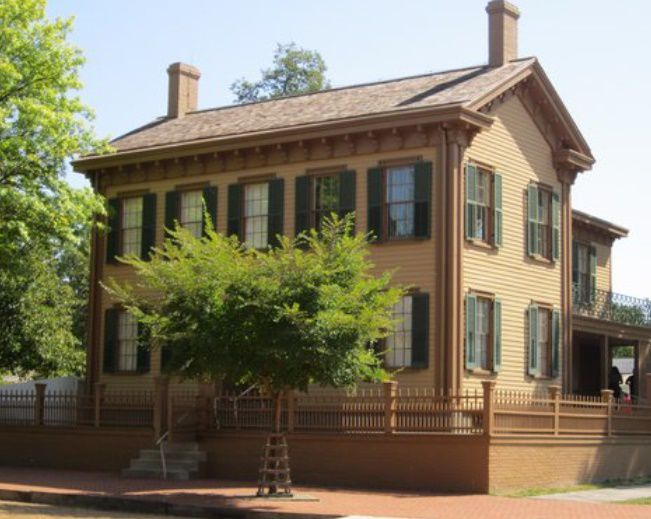
Tickets are free but limited and on a first-come, first serve.
Abraham and Mary Todd Lincoln lived in the 12-room, Greek Revival house for 17 years. It has been restored to its 1860 appearance. While Lincoln lived here his legal and political career soared, topped by his 1860 campaign for president.
Abraham Lincoln Presidential Library and Museum
Six blocks from Lincoln’s home, his life story is celebrated in an extraordinary, imaginative, and proportionate scale to his legacy.
The Abraham Lincoln Presidential Library and Museum does not presume you know his biography, yet is immensely satisfying to those who do.
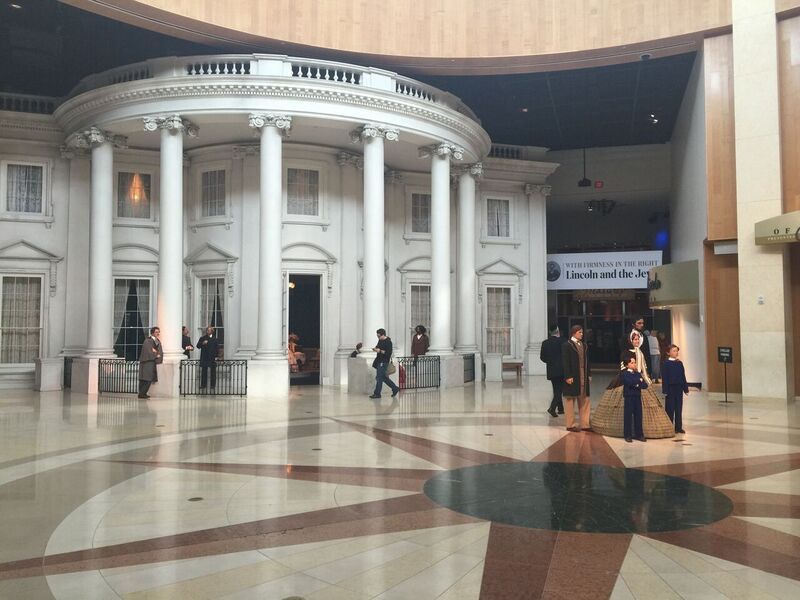
The 140-year gap between Lincoln’s death and the opening of his presidential library in 2005 is difficult to fathom, but the failure to build it sooner was apparently a blessing in disguise. Combining scholarship and showmanship, the museum, like Lincoln himself, is “of the people, for the people and by the people,” a 200,000-square-foot interactive marvel designed for historic accuracy utilizing world-class technology.
On this leg of our trip, we were joined by my sister, Angie, her husband, Jerry, and their son, Matthew, a teenage presidential historian in his own right. As we explored different periods of Lincoln’s life via separate wings, I was struck by the museum’s wide appeal across generations and backgrounds.
A life-sized Lincoln family stands ready for visitors to join them for photos in the plaza, the 1861 South Portico of the White House in the background. On one side of the portico veranda stands Union Generals McClellan and Grant. Frederick Douglass and Sojourner Truth stand on the other side. Unfortunately, the museum decided to also include the figure of Lincoln assassin John Wilkes Booth leaning against one of the columns.
Elsewhere, Lincoln’s assassination and the national mourning are depicted in fittingly somber and serious tones. It was in the museum’s re-creation of Lincoln’s casket lying in state at the Illinois Capitol that my sons absorbed the tragedy of Lincoln’s death and his sacrifice for our country. The nation’s mourning for the martyred president continues here in perpetuity. We quietly filed through, pausing respectfully as we imagined ourselves in 1865.
A similarly haunting tableau captures Abraham and Mary Lincoln tending to their ill son, Willie, in his White House bedroom two weeks before his death.
 In another moment frozen in time, Booth is seen about to enter Lincoln’s box at Ford’s Theater.
In another moment frozen in time, Booth is seen about to enter Lincoln’s box at Ford’s Theater.
Among the artifacts in the museum are Lincoln’s stovepipe hat, briefcase, handwritten copy of the Gettysburg Address, a signed commemorative copy of the Emancipation Proclamation, and his deathbed.
Here, again, we see a reproduction of Lincoln’s boyhood log cabin.
I imagine some traditionalists may prefer a more typical museum experience. To paraphrase Lincoln, I suggest it is altogether fitting and proper that we should honor him in a way that extends his life and most effectively honors his memory among successive generations of Americans.
Lincoln Tomb
My generation of Lincoln-ites may best remember his final resting place as our Lincoln site. About 3 miles north of the museum, Lincoln’s Tomb is a dose of reality at Oak Ridge Cemetery.
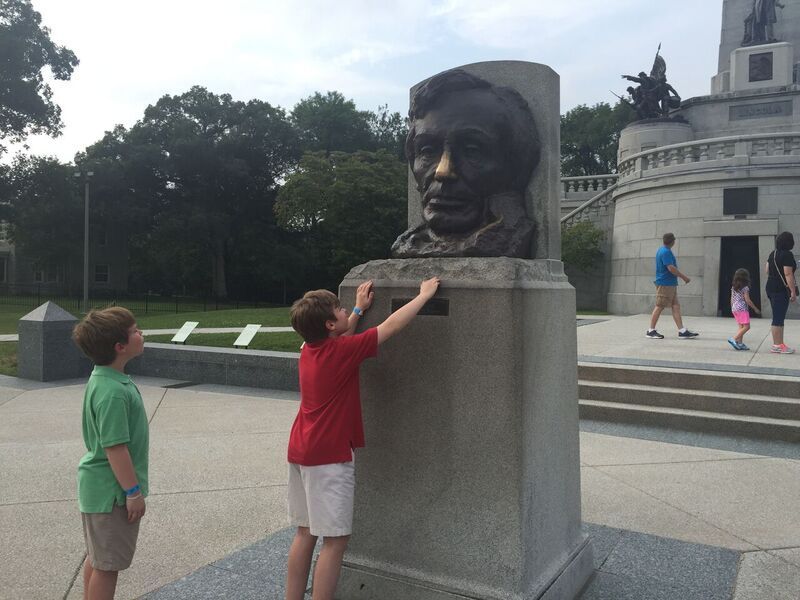 The 117-foot-tall obelisk towers over the granite tomb. Statuary representing various units of the Union Army guard Mr. Lincoln, his bronze standing with an arm extended, as in mid-sentence.
The 117-foot-tall obelisk towers over the granite tomb. Statuary representing various units of the Union Army guard Mr. Lincoln, his bronze standing with an arm extended, as in mid-sentence.
I am surprised that modern-day sensibilities have not ended the tradition of rubbing Lincoln’s nose for good luck. A huge bronze bust of Lincoln, by Mount Rushmore sculptor Gutzon Borglum, continues to have a quirky golden gleam where millions of admirers have reached to touch the nose.
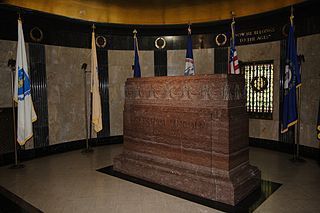 Inside the tomb, we are again reminded that Lincoln and his family were real people. Deep into the marble corridor are the graves of Lincoln, his wife Mary, and three of his four sons—Edward, William, and Thomas (Tad).
Inside the tomb, we are again reminded that Lincoln and his family were real people. Deep into the marble corridor are the graves of Lincoln, his wife Mary, and three of his four sons—Edward, William, and Thomas (Tad).
Whether it is by design or by serendipity, the corridors act as a time machine, transporting tourists to 1865.
Washington, DC
I thank Jimmy Stewart, Frank Capra, and the 1939 movie Mr. Smith Goes to Washington for my fascination with the Lincoln Memorial.
It has become known as much for the stage it provided for historic events, such as the “I Have a Dream Speech” of Dr. Martin Luther King, as it is a memorial to the 16th president. Incidentally, visitors can thank two Louisvillians for King’s speech being officially recognized as a permanent part of the memorial. After Tom Williams and his family tried to identify the location King stood on the memorial steps, he petitioned U.S. Rep. Anne Northup (Ky-3) to introduce legislation directing the Secretary of the Interior to mark the location.
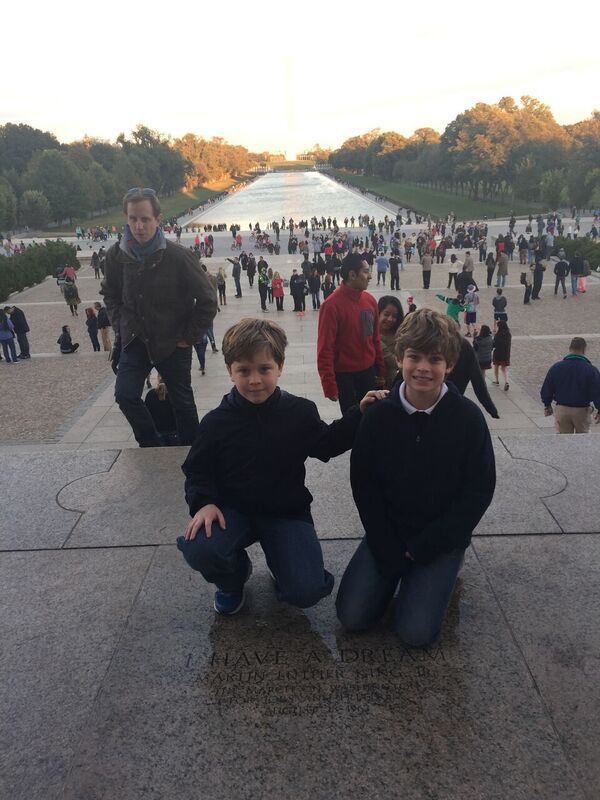 The subsequent act of Congress resulted in this inscription being chiseled into the granite landing.
The subsequent act of Congress resulted in this inscription being chiseled into the granite landing.
I HAVE A DREAM
MARTIN LUTHER KING, JR.
THE MARCH ON WASHINGTON
FOR JOBS AND FREEDOM
AUGUST 28, 1963
But back to Jimmy Stewart. His character in the film, newly appointed U.S. Senator Jefferson Smith, visits the Lincoln Memorial and pays witness to what Lincoln means to this nation. As a man helps his grandson read aloud the inscribed Gettysburg Address, an elderly African-American man walks toward  the sculpted Lincoln, removing his hat out of respect.
the sculpted Lincoln, removing his hat out of respect.
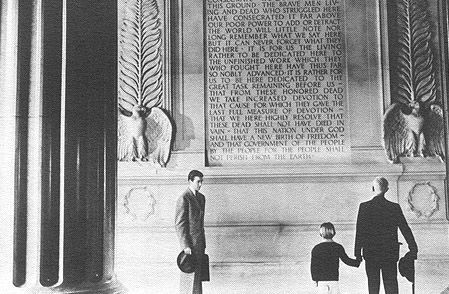
“That this nation under God shall have a new birth of freedom.”
This unbridled patriotism has become out of fashion, if not outright mocked, in my lifetime as nostalgic and unwarranted. Yet every time I visit the Lincoln Memorial, I pay my respects to Mr. Lincoln and I stand to read the inscribed speeches, the Gettysburg Address and his Second Inaugural Address. Like the grandfather in the movie, I stood beside my young sons encouraging them to read each word as both a tribute to their author and as an education and inspiration for the readers.
The good news is that the memorial continues to draw visitors from across the world. The bad news is that unless you visit very early or very late, the throngs of tourists have become disrespectful of Mr. Lincoln’s memory, conducting themselves as if partying after the prom.
By the time we had climbed the steps of the memorial, Sam, Henry, and I had traveled to where Lincoln was born, raised, worked, and buried. I watched as Henry walked closer to the inscribed words, craning his neck to take them in. Sam stood stoically, reading silently. Our Year of Lincoln had apparently made an impression.
Two more stops awaited us.
The White House
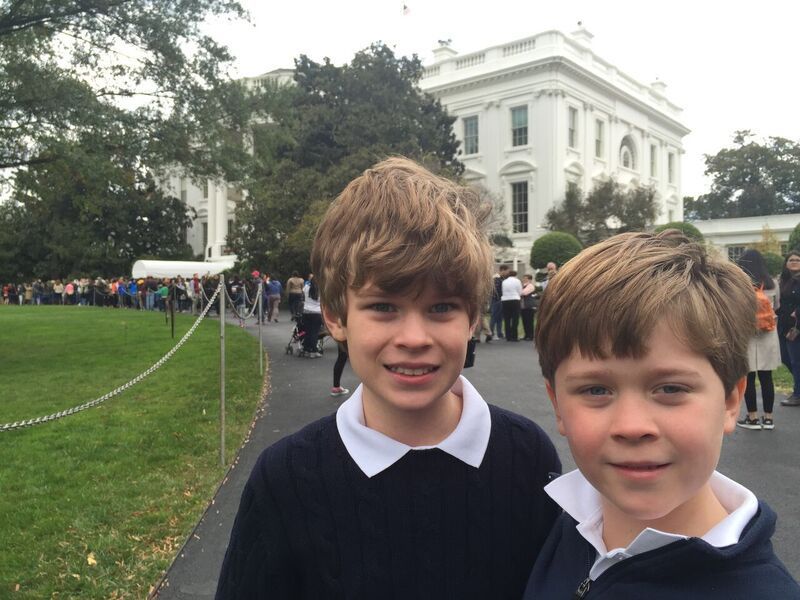 The Washington, D.C. leg of our Year of Lincoln doubled as our family vacation during my sons’ Fall Break, so my wife, Whitney, joined our quest and an extended weekend whirlwind of museums and monuments. Unable to secure passes for a tour of the White House, we were fortunate to visit on one of the two weekends of the year that the White House grounds are opened to tourists for a garden tour.
The Washington, D.C. leg of our Year of Lincoln doubled as our family vacation during my sons’ Fall Break, so my wife, Whitney, joined our quest and an extended weekend whirlwind of museums and monuments. Unable to secure passes for a tour of the White House, we were fortunate to visit on one of the two weekends of the year that the White House grounds are opened to tourists for a garden tour.
Walking up the driveway to the Executive Mansion, I was again unashamed to celebrate my family’s pride in our country.
I pointed to the second floor windows and the residence of President Barack Obama. It was out of a second-floor window two days after the surrender of Confederate General Robert E. Lee that President Lincoln heard the calls of a cheering throng and delivered what turned out to be his last public address, speaking of reconstruction and expressing support for blacks to have the right to vote.
John Wilkes Booth was in the audience and vowed, “That is the last speech he will make.”
Ford’s Theatre
Which brings us to Ford’s Theatre, a place again of great contrasts.
Lincoln enjoyed the theatrical plays and laughter of the converted Baptist church, yet it is where one of America’s most famous actors took the president’s life.
Visiting the theater complex today, its claim is to infamy. Though the National Park Service is respectful in its treatment of the assassination story, the macabre nature of the site is inescapable.
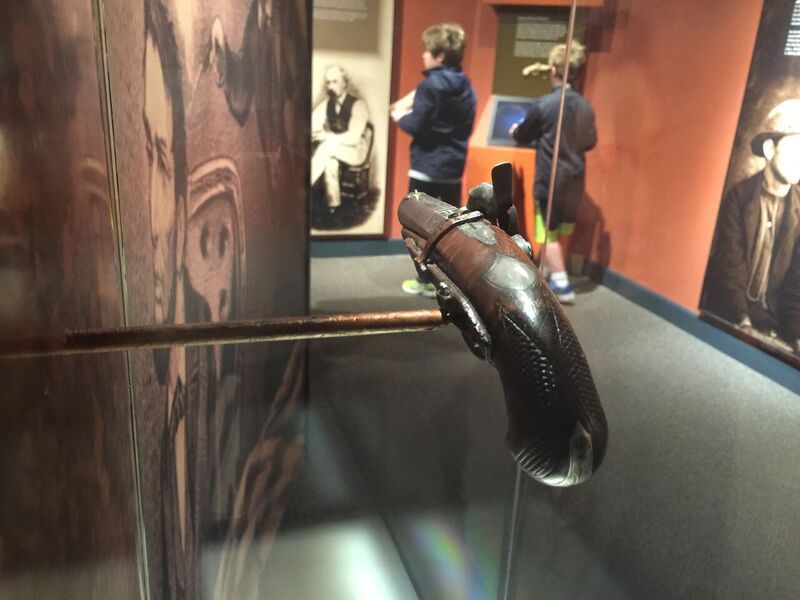 Here we see the 8-ounce brass, single-shot .44 caliber deringer pistol Booth used to kill President Lincoln. Also on display, the clothes Lincoln was wearing when he was shot, a frock coat, waistcoat, trousers, tie, and boots. Booth’s compass and diary are also part of the collection.
Here we see the 8-ounce brass, single-shot .44 caliber deringer pistol Booth used to kill President Lincoln. Also on display, the clothes Lincoln was wearing when he was shot, a frock coat, waistcoat, trousers, tie, and boots. Booth’s compass and diary are also part of the collection.
The tour begins in the lower floor museum, then up a flight of stairs to the theater balcony where visitors can sit, absorb the room, and stare at the presidential box decorated as it was the night of the assassination.
An actor portraying a police detective held court in the balcony during our visit, describing the events of that awful night and answering questions. He was surprised by the topic of my son’s question, for more information about one of the men arrested in the assassination conspiracy, Samuel Arnold, the same name as my eldest son.
For the record, though Samuel Arnold discussed a plot to kidnap Lincoln, which ultimately did not happen, he is not believed to have played a role in the assassination. And we do not believe he is related to my family.
Yet, studying one of the lesser known characters in the saga helps blow the dust off an historic moment to see it in a contemporary light.
The Peterson House
It is a similar sensation across the street in the Petersen house where Lincoln was carried into cramped upstairs quarters and where he died.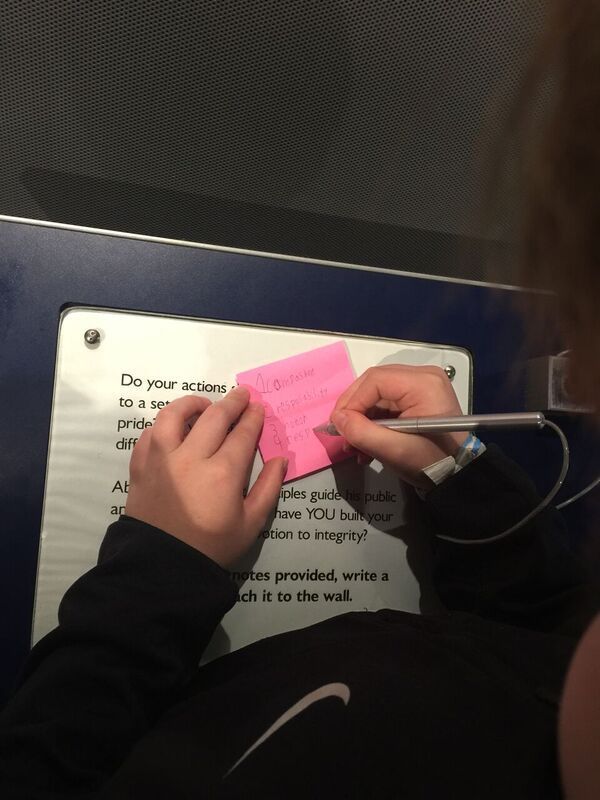
The house’s exhibits address the immediate aftermath of Lincoln’s death and the evolution of his legacy. A 34-foot book tower of books, aluminum reproductions of 6,800 books about Lincoln, show the intense and abiding interest in him.
At one display, below the word “Integrity,” visitors are encouraged to write their own thoughts about that word and Lincoln.
On a Post-It Note, my son Henry listed:
Compashon
resposability
honor
respect
Henry immediately conceded, “I think I spelled ‘compassion’ wrong.”
Postlude
I am glad we made the assassination the final stop on our Year of Lincoln journey, if only to allow my sons the opportunity to learn about him as a real person first rather than a president who was murdered. A real person who—like them—was born in Kentucky. A man who did not have elite privilege or airs, yet is considered one of our greatest Americans. A leader who had the courage of his convictions to hold firm on unpopular positions and fight for a greater cause.
I would like to think that by retracing significant moments in Lincoln’s life at the actual places where they happened we honored his memory and got to know him.
As a family, our journey of some 1,600 miles, from Louisville to Hodgenville, Rockport to the Spencer County, Indiana, farm, Springfield to Washington, D.C., and 1600 Pennsylvania Avenue, also served as a natural opportunity to teach values and instill a love of country, just as my dad did for me 40 years ago.
Lincoln links & resources
Lincoln Birthplace
Abraham Lincoln Birthplace National Historical Park
2995 Lincoln Farm Road
Hodgenville, KY 42748
The Boyhood Home at Knob Creek Unit of the park is open seasonally from April to October from 8:30 am to 4:30 pm and closed from November to March.
Standard Hours: 8 am–4:45 pm
Lincoln Tomb
Oak Ridge Cemetery
1441 Monument Ave, Springfield, IL 62702
Hours for the Lincoln Tomb: 9 am–5 pm Daily
Abraham Lincoln Presidential Library & Museum
212 N. Sixth St., Springfield, IL 62701
9 am–5 pm Daily (Last ticket sold at 4 pm)
Adults $15
Seniors (62+) $12
Military (ID required) $10
Children (5-15) $6
4 and under, no charge
Student (ID required) $12
Library
112 N. Sixth St., Springfield, IL 62701
9 am–5 pm Monday–Friday
Open some weekends for exhibit viewing.
Call (217) 558-8844
No admission charge.
Lincoln Home National Historic Site
426 S. 7th Street
Springfield, IL 62701
(217) 492-4241
Hours are 8:30am-5 pm, daily, except on Thanksgiving Day, Christmas Day and New Years Day, when the park is closed.
Lincoln Boyhood National Memorial
3027 East South Street
PO Box 1816
Lincoln City, IN 47552
Open every day except Thanksgiving Day, December 25 and January 1. The park is in the Central Time Zone.
Memorial Visitor Center Hours: April 10, 2016, to September 24, 2016: Daily 8 am–5 pm.
Lincoln Living Historical Farm
April 10, 2016, to May 29, 2016: Staffed Wednesday through Sunday 8 am–5 pm
May 30, 2016, to mid-August: Staffed daily 8 am–5 pm
Mid-August to September 24: Staffed Wednesday through Sunday 8 am–5 pm
Note: When the farm is not staffed visitors may browse the farm site.
Rockport Lincoln Pioneer Village
928 Fairground Dr, Rockport, IN 47635
May 1–October 31 Open Daily: 9am -5pm (Central Standard Time)
November 1–December 31:Weekends Only: 9am – 5pm (Central Standard Time)
January 1–April 30: Closed
Admission: Adults $5; Seniors (50 and over) $3; Children (12 and under) $3
WASHINGTON, D.C.
Ford’s Theatre
Tours from 9 am–5 pm
Box Office open from 8:30 am–5 pm
Free, but a ticket is required.
The Petersen House
Tours from 9:30 am–5:30 pm daily
Free, but a ticket is required.






